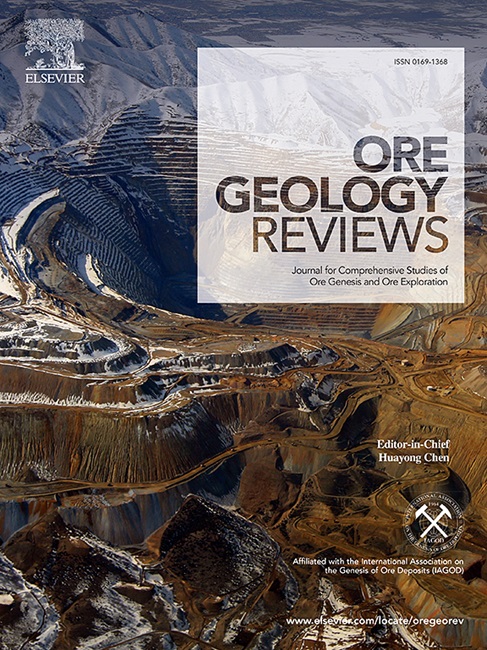Quartz geochemical constraints on the origin of stratabound deposits, Eastern China: Insights from the Xinqiao deposit
IF 3.2
2区 地球科学
Q1 GEOLOGY
引用次数: 0
Abstract
Stratabound deposits with origin-undetermined footwall quartz-pyrite stockwork mineralization in the Middle-Lower Yangtze River Valley metallogenic belt (Eastern China) have uncertain metallogenic models. The Xinqiao deposit, a notable example in the Tongling ore district, provides an ideal case for studying the footwall stockwork mineralization to elucidate the origin of the stratiform mineralization. Cathodoluminescent imaging reveals three generations of quartz within the Xinqiao stockwork mineralization: homogeneous quartz (Qz1), oscillatory-zoned quartz (Qz2) coexisting with pyrite and enclosing Qz1, and weakly oscillatory-zoned quartz (Qz3) replacing Qz2. Quartz trace elements geochemistry (high Al (65.1–2849 ppm) and Ti (3.10–90.9 ppm), low Mn (0.980–20.0 ppm), As (1.56–10.2 ppm), and Sb (0.123–5.21 ppm)), combined with quartz-pyrite assemblage, suggests a magmatic-hydrothermal origin for the stockwork mineralization linked to the Early Cretaceous Jitou stock. Variations in Ti, Ge/Ti, and Al contents across three quartz generations indicate a temperature increase from Qz1 to Qz2 (>400 ℃), followed by a decrease (<350 ℃) during Qz3 formation, accompanied by a continuous pH decline. The injection of high-temperature magmatic-hydrothermal fluid would trigger the rapid crystallization of Qz1 with high trace elements (e.g., Fe, Cu, Zn, and Pb) during initial infiltration and hydraulic fracturing. A subsequent fluid pulse with minor meteoric water precipitate pyrite and Qz2, while meteoric water dominance during a waning magmatic-hydrothermal system led to Qz3 formation. These findings highlight the utility of quartz textures and trace element geochemistry in reconstructing the mineralization history and providing insights into the ore genesis in stratabound deposits within the Middle-Lower Yangtze River Valley metallogenic belt and similar metallogenic settings globally.

求助全文
约1分钟内获得全文
求助全文
来源期刊

Ore Geology Reviews
地学-地质学
CiteScore
6.50
自引率
27.30%
发文量
546
审稿时长
22.9 weeks
期刊介绍:
Ore Geology Reviews aims to familiarize all earth scientists with recent advances in a number of interconnected disciplines related to the study of, and search for, ore deposits. The reviews range from brief to longer contributions, but the journal preferentially publishes manuscripts that fill the niche between the commonly shorter journal articles and the comprehensive book coverages, and thus has a special appeal to many authors and readers.
 求助内容:
求助内容: 应助结果提醒方式:
应助结果提醒方式:


